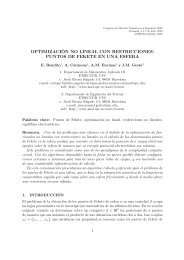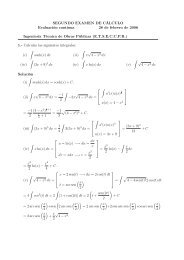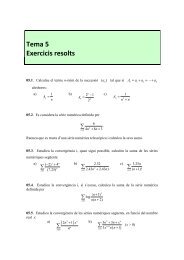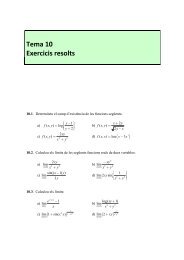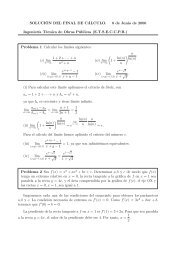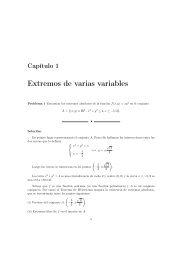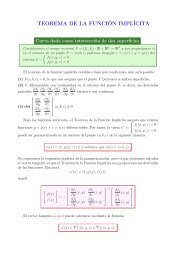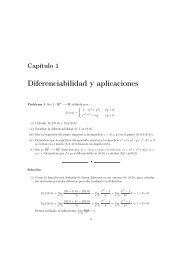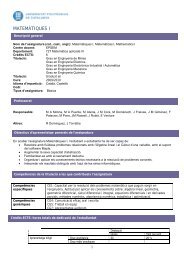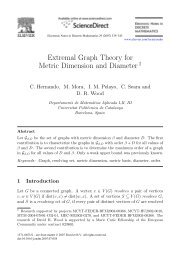Approaching predator-prey Lotka-Volterra Equations by Simplicial ...
Approaching predator-prey Lotka-Volterra Equations by Simplicial ...
Approaching predator-prey Lotka-Volterra Equations by Simplicial ...
You also want an ePaper? Increase the reach of your titles
YUMPU automatically turns print PDFs into web optimized ePapers that Google loves.
Proceedings of the 4th International Workshop<br />
on Compositional Data Analysis (2011)<br />
<strong>Approaching</strong> <strong>predator</strong>-<strong>prey</strong> <strong>Lotka</strong>-<strong>Volterra</strong> equations <strong>by</strong><br />
simplicial linear differential equations<br />
E. JARAUTA-BRAGULAT 1 and J. J. EGOZCUE 1<br />
1 Dept. Matemàtica Aplicada III, U. Politècnica de Catalunya, Barcelona, Spain (eusebi.jarauta@upc.edu)<br />
Abstract<br />
Predator-<strong>prey</strong> <strong>Lotka</strong>-<strong>Volterra</strong> equations was one of the first models reflecting interaction of different species and<br />
modeling evolution of respective populations. It considers a large population of hares (<strong>prey</strong>s) which is depredated<br />
<strong>by</strong> an also large population of lynxes (<strong>predator</strong>s). It proposes an increasing/decreasing law of the number of<br />
individuals in each population thus resulting in an apparently simple system of ordinary differential equations.<br />
However, the <strong>Lotka</strong>-<strong>Volterra</strong> equation, and most of its modifications, is non-linear and its generalization to a<br />
larger number of species is not trivial. The present aim is to study approximations of the evolution of the<br />
proportion of species in the <strong>Lotka</strong>-<strong>Volterra</strong> equations using some simple model defined in the simplex.<br />
Calculus in the simplex has been recently developed on the basis of the Aitchison geometry and the simplicial<br />
derivative. Evolution of proportions in time (or other parameters) can be represented as simplicial ordinary<br />
differential equations from which the simpler models are the linear ones. <strong>Simplicial</strong> Linear Ordinary Differential<br />
<strong>Equations</strong> are not able to model the evolution of the total mass of the population (total number of <strong>predator</strong>s plus<br />
<strong>prey</strong>s) but only the evolution of the proportions of the different species (ratio <strong>predator</strong>s over <strong>prey</strong>s). This way of<br />
analysis has been successful showing that the compositional growth of a population in the Malthusian exponential<br />
model and the Verhulst logistic model were exactly the same one: the first order simplicial linear differential<br />
equation with constant coefficients whose solution is a compositional straight-line. This strategy of studying the<br />
total mass evolution and the compositional evolution separately is used to get a simplicial differential equation<br />
whose solutions approach suitably the compositional behavior of the <strong>Lotka</strong>-<strong>Volterra</strong> equations. This approach<br />
has additional virtues: it is linear and can be extended in an easy way to a number of species larger than two.<br />
1 Introduction<br />
Systems of ordinary differential equations have been frequently used to model the behaviour of populations,<br />
understanding populations in a wide sense: biological, human, resources, epidemia, etc. (Bacaër,<br />
2011). The population is partitioned into classes of individuals and the number of individuals in each<br />
class is treated as a continuous real variable. This continuous number of individuals of a class will be<br />
called mass of the class. Elementary models express the derivative of the mass of a class as a simple<br />
function of the number of all masses. Solutions of this kind of differential equations are generically<br />
known as growth curves (Odum, 1971). The simplest and older model is the exponential growth model<br />
which appear in bacteria growth, human communities (Euler, 1760), radioactive decay, etc. and it can<br />
be formulated as<br />
Dm i (t) = k i m i (t) , i = 1, 2, . . . , n , (1)<br />
where m i (t) represents the mass of the i-th class as a function of time t; D is the ordinary derivative<br />
operator with respect to t and n is the number of classes. Model (1) can be complemented with new<br />
classes of individuals without changing the meaning of the equations. For instance, the traditional<br />
Euler-Malthus model is Dm 1 = k 1 m 1 being m 1 the individuals of a human population and k 1 > 0. If<br />
m 1 (0) is the initial mass, the solution of the differential equation is m 1 (t) = m 1 (0) exp(k 1 t), t ≥ 0. We<br />
can redefine the population as made of resources cells: some of them, m 1 (t), occupied <strong>by</strong> individuals;<br />
and those cells which are available, m 2 (t). Assuming that m 2 (t) is a constant it satisfies the differential<br />
equation Dm 2 = 0. Solving for the system (1), with n = 2, k 1 > 0, k 2 = 0, the solution of the mass<br />
m 1 (t) is exactly the previous one.<br />
An apparently more complex model is the logistic one (Verhulst, 1838). It can be written as<br />
Dm 1 (t) = k 1 m 1 (t) (m ∞ 1 − m 1 (t)) , k 1 > 0 , (2)<br />
Egozcue, J.J., Tolosana-Delgado, R. and Ortego, M.I. (eds.)<br />
ISBN: 978-84-87867-76-7<br />
1<br />
1
Proceedings of the 4th International Workshop<br />
on Compositional Data Analysis (2011)<br />
which is a non linear-Ricatti equation whose solution is the well known logistic curve, and m ∞ 1 is the<br />
asymptotic mass of population. Again equation (2) can be complemented with an equation for the<br />
available resource cells. An option is m 2 = M −m 1 , M > 0, or equivalently Dm 2 = −k 1 m 1 (m ∞ 1 −m 1)<br />
which maintains the solution for m 1 (t) unaltered.<br />
Another class of models of population growth is the so called SIR-models (and generalisations).<br />
Let m 1 ≡ S, m 2 ≡ I, m 3 ≡ R the mass of susceptible to a disease, the mass of infected people, and the<br />
mass of recovered people, respectively. Whenever the latent evolution of the population is neglected<br />
the SIR-model (Kermack and McKendrick, 1927) is<br />
Dm 1 (t) = −αm 1 (t)m 2 (t) , Dm 2 (t) = αm 1 (t)m 2 (t) − γm 2 (t) , Dm 3 (t) = γm 2 (t) , (3)<br />
for some positive constants α, γ. This model has been successfully used in prediction of epidemics<br />
evolution.<br />
Also <strong>predator</strong>-<strong>prey</strong> <strong>Lotka</strong>-<strong>Volterra</strong> equations, and their sequels, corresponds to the same type of<br />
equations. If m 1 represents the mass of <strong>predator</strong>s, m 2 the mass of <strong>prey</strong>s then <strong>Lotka</strong>-<strong>Volterra</strong> equations<br />
are<br />
Dm 1 (t) = −a 1 m 1 (t) + a 2 m 1 (t)m 2 (t) , Dm 2 (t) = b 1 m 2 (t) − b 2 m 1 (t)m 2 (t) , (4)<br />
where the coefficients a 1 , a 2 , b 1 , b 2 are assumed positive. Despite of the apparent simplicity of these<br />
equations, their solution is not explicit although the orbit (m 1 (t), m 2 (t)) is easily obtained. Figure 1<br />
(left) shows <strong>predator</strong>-<strong>prey</strong> (lynx-hare) data used in Section 4 as an example and at the right panel one<br />
cycle orbit described <strong>by</strong> observed data (blue) and the orbit of the solution of <strong>Lotka</strong>-<strong>Volterra</strong> equations<br />
fitted to the data set.<br />
All cited examples can be viewed in two different ways: the traditional representation using masses<br />
of each class as in equations (1), (2), (3), (4); an alternative consisting of representing the system as an<br />
equation for the total mass m(t) = ∑ i m i(t) and a simplicial differential equation for the composition<br />
containing the proportion of masses, i.e. x(t) = C(m 1 (t), m 2 (t), . . . , m n (t)) ∈ S n where C is the closure<br />
to unit and S n the n-part simplex. The difference between these two representations is the metric<br />
of the space where the solutions are defined. In the traditional case, masses evolve in R n + assuming<br />
that the metric is inherited from the Euclidean space R n . In the second case, the representation, total<br />
mass and composition, is a curve in the space R + × S n which is also a n-dimensional Euclidean space<br />
(Pawlowsky-Glahn and Egozcue, 2001). This strategy separating the compositional model from the<br />
total mass evolution has been successful proving that the compositional differential equation for the<br />
Euler-Malthus Eq. (1), with n = 2, k 1 > 0, k 2 = 0, and the logistic Verhulst model (2) are just<br />
equal, and they only differ in the behaviour of the total mass (Jarauta-Bragulat and Egozcue, 2008,<br />
2010). Moreover, in the case of the logistic model (2), the compositional equation is a first order<br />
linear equation which is simpler than the Eq. (2) itself. This previous results suggest that, in some<br />
cases, models expressed in mass may be simplified or approached studying their compositional and<br />
total mass models separately.<br />
Attention is now focussed in the <strong>Lotka</strong>-<strong>Volterra</strong> system (4). The main idea is that these equations<br />
can be approached <strong>by</strong> simple compositional and total mass models. These simple models have been<br />
chosen to be harmonic oscillators (Section 4) for the total mass and for the compositional part being<br />
the natural frequency equal in both equations.<br />
2 Linear differential equations in S n and R +<br />
Derivatives on the simplex<br />
<strong>Simplicial</strong> derivatives have been defined in Aitchison (1986) (postscript 2003 printing) and also in<br />
Aitchison et al. (2002), Egozcue et al. (2008). A more detailed development is found in Egozcue et al.<br />
(2011). If f : R → S n is a function of a real variable (time) on the simplex (proportions of masses),<br />
the simplicial derivative of f at t is defined as<br />
( )<br />
1<br />
D ⊕ f(t) = lim<br />
h→0 h ⊙ (f(t + h) ⊖ f(t)) , (5)<br />
Egozcue, J.J., Tolosana-Delgado, R. and Ortego, M.I. (eds.)<br />
ISBN: 978-84-87867-76-7<br />
2
Proceedings of the 4th International Workshop<br />
on Compositional Data Analysis (2011)<br />
250<br />
100<br />
200<br />
75<br />
Indivuduals (thousands)<br />
150<br />
100<br />
thousands of hares<br />
50<br />
50<br />
25<br />
0<br />
0 10 20 30 40 50<br />
time (year)<br />
lynxes hares mass<br />
0<br />
0 25 50 75 100<br />
thousands of lynxes<br />
Figure 1: Left, observed number (in thousands) of hares and lynxes 1885-1935 (Odum, 1971). Right, periodic orbits of<br />
(m 2, m 1) as observed (blue), for fitted <strong>Lotka</strong>-<strong>Volterra</strong> equations (LV, red) and the proposed harmonic oscillator<br />
(HO, green) fitted to data. The central dot is the equilibrium value estimated for both LV and HO.<br />
if the limit exists. In Equation (5), standard notation of operations in the simplex is adopted: ⊕ is<br />
perturbation and ⊖ is the opposite of perturbation; ⊙ denotes powering <strong>by</strong> real scalars. Computation<br />
of the derivative is easily carried out using logarithmic derivatives,<br />
(<br />
D ⊕ Df1 (t)<br />
f(t) = C exp (D log(f(t))) = C exp<br />
f 1 (t) , . . . , Df )<br />
n(t)<br />
, (6)<br />
f n (t)<br />
where functions (exp, log, . . . ) operate componentwise on vectors. Moreover, f is not necessarily closed<br />
to unit because any equivalent (proportional) function gives the same result. A further simplification<br />
consists of expressing the compositional function in coordinates with respect to any orthonormal basis.<br />
If ilr : S n → R n−1 assigns orthonormal coordinates to any composition (Egozcue et al., 2003; Egozcue<br />
and Pawlowsky-Glahn, 2005, 2006), then<br />
D ⊕ f(t) = ilr −1 (D(ilr(f))) , (7)<br />
where again D denotes derivative with respect to the real variable (time).<br />
Using expressions Eq. (6) and (7), K-order simplicial linear (ordinary) differential equations<br />
(SLODE) expressed in the simplex are<br />
K⊕<br />
a k ⊙ (D ⊕ ) k x(t) = ϕ(t) ,<br />
k=0<br />
being (D ⊕ ) k the k-th simplicial derivative ((D ⊕ ) 0 is the identity) and ϕ a forcing compositional term.<br />
Once an orthonormal basis of the simplex is selected, the compositional functions x(t) and ϕ(t) can<br />
be expressed using their coordinates, i.e. x ∗ (t) = (x ∗ 1 (t), x∗ 2 (t), . . . , x∗ n−1 (t)) = ilr(x(t)) (analogously<br />
for ϕ(t)), given rise to a system of n − 1 linear ordinary differential equations<br />
K∑<br />
a k · D k x ∗ (t) = ϕ ∗ (t) .<br />
k=0<br />
Methods for solving this kind of differential equations are well-known and can be applied without any<br />
restriction. Once a solution for the coordinates x ∗ is known it can be immediately translated into the<br />
compositional solution as x = ilr −1 (x ∗ ).<br />
Derivatives in R +<br />
Whenever a relative scale in R + is assumed, differences are no longer measured <strong>by</strong> ordinary differences<br />
but logarithmic differences (Pawlowsky-Glahn and Egozcue, 2001). Therefore, a derivative of a<br />
Egozcue, J.J., Tolosana-Delgado, R. and Ortego, M.I. (eds.)<br />
ISBN: 978-84-87867-76-7<br />
3
Proceedings of the 4th International Workshop<br />
on Compositional Data Analysis (2011)<br />
function f : R → R + needs a re-definition. The idea is that R + is a one-dimensional Euclidean space,<br />
where the group operation (addition, also denoted ⊕) is the ordinary product and the external operation<br />
(denoted ⊙) is powering. Similarly to the simplex, a basis can be defined so that any element<br />
in R + can be represented <strong>by</strong> its coordinate with respect to the basis. A simple choice of a basis in<br />
R + is the number e = exp(1) which allows the coordinate expression x = exp(log x) for any x ∈ R + .<br />
Therefore, log x ∈ R is the coordinate of x ∈ R + when the selected basis is e. After these concepts,<br />
the derivative for the coordinates of functions in R + is<br />
D(log f(t)) = lim<br />
h→0<br />
log f(t + h) − log f(t)<br />
h<br />
which translated back to R + gives the desired derivative<br />
D + f(t) = exp (D(log f(t))) ,<br />
,<br />
which clearly recalls derivatives in the simplex (5-7).<br />
Differential equations in R + can be equivalently written using D + or using coordinates.<br />
instance, a K-order linear differential equation in R + is<br />
For<br />
K⊕<br />
a k ⊙ (D + ) k x(t) = ϕ(t) ,<br />
k=0<br />
where, for x, y ∈ R + , α ∈ R, x ⊕ y = exp(log x + log y) = xy, α ⊙ x = exp(α log x) = x α ; x(t) is the<br />
unknown positive function and ϕ(t) represents a positive forcing term. This equation can be written<br />
in coordinates<br />
K∑<br />
a k · D k x ∗ (t) = f ∗ (t) , x ∗ (t) = log x(t) , ϕ ∗ (t) = log ϕ(t) ,<br />
k=0<br />
which is a linear ordinary differential equation in R.<br />
Total mass and compositional models<br />
An important point is how to get the total mass and the compositional evolution equations from the<br />
differential equations for masses of the classes. There are essentially two ways to do it. The first one<br />
is to solve the system in masses; then, compute proportions and their representation in coordinates;<br />
and finally, obtain the simplicial differential equations from the solution in coordinates. Although<br />
apparently simple, this way is plenty of difficulties: the solution in mass should be explicit and also<br />
the solution in coordinates; and afterwards, the identification of the differential equation should be<br />
feasible. A second way, which may be considered standard, starts transforming the derivatives of the<br />
differential equation in mass into logarithmic derivatives, and then, expressing the remaining term<br />
in a compositional way. Even simple equations in mass can exhibit unexpected links between the<br />
compositional part of the equation and the total mass equation. If this is the case, little benefit<br />
is obtained from expressing the equations of the system as compositional and total mass equations.<br />
However, if the compositional and total mass equations are not coupled, then the interpretation of the<br />
model is simplified.<br />
3 <strong>Lotka</strong>-<strong>Volterra</strong> equations<br />
The <strong>predator</strong>-<strong>prey</strong> <strong>Lotka</strong>-<strong>Volterra</strong> equations (4) are<br />
Dm 1 (t) = −a 1 m 1 (t) + a 2 m 1 (t)m 2 (t) , Dm 2 (t) = b 1 m 2 (t) − b 2 m 1 (t)m 2 (t) , (8)<br />
where m 1 (t) is the mass of <strong>predator</strong>s, m 2 (t) is the mass of <strong>prey</strong>s and m(t) = m 1 (t) + m 2 (t) is the<br />
total mass. It is interesting to pay attention to the reasoning that leads to both equations in (8). It<br />
can be summarised as: the mass of <strong>predator</strong>s decreases proportionally to the <strong>predator</strong> mass because<br />
<strong>predator</strong> individuals compite for their territory; and the mass of <strong>predator</strong>s increases proportionally to<br />
Egozcue, J.J., Tolosana-Delgado, R. and Ortego, M.I. (eds.)<br />
ISBN: 978-84-87867-76-7<br />
4
Proceedings of the 4th International Workshop<br />
on Compositional Data Analysis (2011)<br />
the number of encounters between <strong>predator</strong>s and <strong>prey</strong>s which is the way of feeding <strong>predator</strong>s; moreover,<br />
the number of <strong>predator</strong>-<strong>prey</strong> encounters is proportional to the product of masses of <strong>predator</strong>s and <strong>prey</strong>s.<br />
Similarly, the mass of <strong>prey</strong>s increases proportionally to <strong>prey</strong>s mass, provided there is enough vegetal<br />
food for <strong>prey</strong>s; and decreases proportionally to the number of <strong>predator</strong>-<strong>prey</strong> encounters because some of<br />
them conclude with the dead of the <strong>prey</strong>. This kind of reasoning has three remarkable characteristics:<br />
(a) there is no mention of the total mass of <strong>predator</strong>s and <strong>prey</strong>s and it is not sensible to the mass<br />
of individuals; (b) it implicitly assumes that the way of measuring change of mass is the ordinary<br />
derivative for real functions with the ordinary way of measuring differences; (c) when it is said that<br />
the increase/decrease of the mass is proportional to two quantities, the two proportionality effects on<br />
the change are assumed additive.<br />
Characteristic (a) points out the compositional character that should be present in the equation.<br />
However, Eq. (8) is not scale invariant and the influence of encounters depends on the masses and<br />
not only on their proportions. Point (b) assumes, e.g., that the difference in mass of 100 and 1, 000<br />
individuals is exactly the same as between 1 million and 1 million plus 900 individuals, against the<br />
appreciation of an ecologist that probably feels that 100 is a critical number of individuals for a population<br />
near of extinction; 1000 individuals is dangerous but not critical; and 1, 000, 000 and 1, 000, 900<br />
individuals in two populations are very similar masses. Probably, the ecologist would better understand<br />
that for measure these differences is better to compare the numbers using ratios, 1, 000/100 = 10,<br />
(10 6 + 900)/10 6 ≈ 1. A little step further is to measure the ratio differences taking their logarithm<br />
so that symmetrizing the role of numerator and denominator: in the first case log(10 3 /10 2 ) ≃ 2.3<br />
and the second one log((10 6 + 9 · 10 2 )/10 6 ) ≃ 8 · 10 −4 . Characteristic (c) is a little bit mysterious.<br />
Reasoning mainly mentions proportionality and additivity does not take place. One can think this<br />
was introduced to get a simple equation, but many aspects of <strong>Lotka</strong>-<strong>Volterra</strong> equations (8) are not<br />
simple, and finally the equations must be solved numerically.<br />
Proportion of <strong>predator</strong>s and <strong>prey</strong>s over the total is denoted x = (x 1 , x 2 ) = C(m 1 , m 2 ). Transforming<br />
Eq. (8) to express it using logarithmic derivatives, this is<br />
D log m 1 (t) = −a 1 + a 2 m 2 (t) , D log m 2 (t) = b 1 (t) − b 2 m 1 (t) .<br />
Since x is a composition of two parts, it is represented <strong>by</strong> a single coordinate x ∗ = 2 −1/2 log(x 1 /x 2 ).<br />
The derivative Dx ∗ is the coordinate expression of the simplicial derivative<br />
D ⊕ x = C exp(D log(m 1 , m 2 )) = C exp(D log(x 1 , x 2 )) .<br />
After some algebra<br />
Dx ∗ = √ 1<br />
)<br />
(−(a 1 + b 1 ) + e m∗ (a 2 x 2 + b 2 x 1 )<br />
2<br />
, Dm ∗ = −(a 1 x 1 − b 1 x 2 ) + e m∗ (a 2 − b 2 )x 1 x 2 , (9)<br />
where the proportions x = (x 1 , x 2 ) can be expressed as a function of the coordinate (balance) x ∗ and<br />
the coordinate of m in R + , m ∗ = log m (Pawlowsky-Glahn and Egozcue, 2001). The expressions for<br />
x 1 and x 2 are<br />
x 1 = exp(√ 2 x ∗ )<br />
1 + exp( √ 2 x ∗ )<br />
, x 2 =<br />
1<br />
1 + exp( √ 2 x ∗ ) ,<br />
which<br />
√<br />
is the ilr −1 transformation into S 2 , and also the inverse logit transform up to the constant<br />
2. Although <strong>Equations</strong> (9) are numerically tractable, they are coupled and they do not offer any<br />
advantage over the original <strong>Lotka</strong>-<strong>Volterra</strong> equations (8).<br />
After these equations using coordinates in R + × S 2 and the criticisms to the underlaying ideas to<br />
<strong>Lotka</strong>-<strong>Volterra</strong> equations, to approach these equations with a simple total mass-compositional model<br />
seems advisable.<br />
4 A simple model approaching <strong>Lotka</strong>-<strong>Volterra</strong> equations<br />
<strong>Lotka</strong>-<strong>Volterra</strong> equations have periodic solutions (Fig. 1, right). This means that the approaching<br />
equations should have solutions for coordinate in S 2 and coordinate in R + which must be also periodic.<br />
Egozcue, J.J., Tolosana-Delgado, R. and Ortego, M.I. (eds.)<br />
ISBN: 978-84-87867-76-7<br />
5
Proceedings of the 4th International Workshop<br />
on Compositional Data Analysis (2011)<br />
160<br />
<br />
thousands of hares<br />
140<br />
120<br />
100<br />
80<br />
60<br />
40<br />
20<br />
<br />
<br />
<br />
<br />
<br />
<br />
<br />
<br />
<br />
0<br />
0 5 10 15 20 25 30 35 40 45 50<br />
time (year)<br />
data LV HO<br />
<br />
<br />
<br />
<br />
Figure 2: Mass, in thousands, of hares (left) and lynxes (right). Observed 1885-1935 (Odum, 1971) (blue); for fitted<br />
<strong>Lotka</strong>-<strong>Volterra</strong> equations (red) and the proposed harmonic oscillator (green).<br />
160<br />
140<br />
140<br />
120<br />
Indivuduals (thousands)<br />
120<br />
100<br />
80<br />
60<br />
40<br />
20<br />
Indivuduals (thousands)<br />
100<br />
80<br />
60<br />
40<br />
20<br />
0<br />
0 10 20 30 40 50<br />
time (year)<br />
lynxes hares mass<br />
0<br />
0 10 20 30 40 50<br />
time (year)<br />
lynxes hares mass<br />
Figure 3: Comparison in time (1885-1935) of number (in thousands) of lynxes, hares and total individuals for the fitted<br />
<strong>Lotka</strong>-<strong>Volterra</strong> equations (LV, left) and for the fitted harmonic oscillator (HO, right).<br />
For simplicity, linear differential equations are preferred as approaching equations, but periodic solutions<br />
are only attained with linear differential equations of order 2 or higher. The simplest model in<br />
R + × S 2 , stated in coordinates, and with periodic solutions is the free oscillating, uncoupled harmonic<br />
oscillator<br />
D 2 µ ∗ + ω 2 µ ∗ = 0 , D 2 y ∗ + ω 2 y ∗ = 0 , (10)<br />
with a single parameter ω which represents the natural angular frequency of oscillation around the<br />
point µ ∗ = 0, y ∗ = 0. Since orbits of <strong>Lotka</strong>-<strong>Volterra</strong> equations are centered on a point which is<br />
determined <strong>by</strong> the coefficients a 1 , a 2 , b 1 , b 2 (8), a shift of the oscillator (10) adapts the oscillator to the<br />
<strong>Lotka</strong>-<strong>Volterra</strong> system. This can be done defining m ∗ = m ∗ 0 +µ∗ and x ∗ = x ∗ 0 +y∗ , where m ∗ 0 = log m 0,<br />
x ∗ 0 = 2−1/2 log(x 10 /x 20 ) represents a shift in coordinates of R + × S 2 ; m 0 is a multiplicative change<br />
in total mass and (x 10 , x 20 ) is a perturbation (shift) in S 2 . This completes a three parameter model<br />
which are ω, m ∗ 0 , and x∗ 0<br />
The general solution of the oscillator (10) is explicit<br />
m ∗ (t) = m ∗ 0 + A m sin(ωt) + B m cos(ωt) , x ∗ (t) = x ∗ 0 + A x sin(ωt) + B x cos(ωt) , (11)<br />
where the constants m ∗ 0 , x∗ 0 , correspond to mean values and A m, B m , A x , B x are determined <strong>by</strong> initial<br />
or boundary conditions.<br />
To show the effectiveness of the proposed approach, a demonstration data set for the <strong>Lotka</strong>-<br />
<strong>Volterra</strong> equation have been used (Odum, 1971). It corresponds to 1845-1935 year record of the mass<br />
of lynxes (<strong>predator</strong>s m 1 ) and mass of hares (<strong>prey</strong>s m 2 ). Only data for years 1885-1935 are used in the<br />
present example as measurements are more reliable. Masses are measured in thousands of individuals.<br />
Parameters of <strong>Lotka</strong>-<strong>Volterra</strong> (LV) and the harmonic oscillator (HO) in Equation 11 have been fitted<br />
Egozcue, J.J., Tolosana-Delgado, R. and Ortego, M.I. (eds.)<br />
ISBN: 978-84-87867-76-7<br />
6
Proceedings of the 4th International Workshop<br />
on Compositional Data Analysis (2011)<br />
Table 1: Parameters for <strong>Lotka</strong>-<strong>Volterra</strong> (LV) equations and the harmonic oscilator (HO) fitted to data. T is the estimated<br />
period in year corresponding to ω.<br />
<strong>Lotka</strong>-<strong>Volterra</strong><br />
a 1 = 0.842 a 2 = 0.019<br />
b 1 = 0.473 b 2 = 0.016<br />
harmonic oscillator<br />
eq. coordinates eq. R + × S n<br />
m ∗ 0 = 4.276 m 0 = 71.953 thousands<br />
x ∗ 0 = −0.273 x 10 = 0.405<br />
x 20 = 0.595<br />
ω = 0.631 (years) −1<br />
T = 9.957 years<br />
3.0<br />
6.0<br />
2.0<br />
5.0<br />
1.0<br />
4.0<br />
0.0<br />
3.0<br />
-1.0<br />
2.0<br />
-2.0<br />
1.0<br />
-3.0<br />
0 10 20 30 40 50<br />
time (year)<br />
ilr LV ilr HO ilr data<br />
0.0<br />
0 10 20 30 40 50<br />
time (year)<br />
log-mass LV log-mass HO log-mass data<br />
Figure 4: Comparison of the coordinates (ilr) of composition (lynxes,hares) and the log-total mass of lynxes (red), hares<br />
(green) and total mass (blue) along 1885-1935. Left: ilr-coordinate x ∗ ; right: log-total mass (thousands) m ∗ .<br />
using least squares. The procedure consists of the following steps: (a) express the data in coordinates<br />
m ∗ (t i ) and x ∗ (t i ) for the sampling times t i ; (b) determine the equilibrium values m ∗ 0 , x∗ 0 as the mean<br />
values along the coordinates; (c) determine the angular frequency ω using Pisarenko harmonic analysis<br />
(Pisarenko, 1973) on the coordinates computed in (a); (d) using the estimated values of m ∗ 0 , x∗ 0 , ω,<br />
determine a 1 , a 2 , b 1 , b 2 and solve numerically the <strong>Lotka</strong>-<strong>Volterra</strong> equations (8) using observed initial<br />
conditions; (e) using the estimated values of m ∗ 0 , x∗ 0 , ω, determine the values A m, B m , A x , B x in<br />
Equation (11) using least squares. The resulting parameters are shown in Table 1.<br />
Figure 1 (left) shows the evolution of the mass of hares (blue) and lynxes (red) as observed along 50<br />
years (1885-1935); also the total mass is reported. In Figure 1 (right) the orbit described <strong>by</strong> data in one<br />
cycle is represented in blue. Also in Figure 1 (right), orbits for the fitted <strong>Lotka</strong>-<strong>Volterra</strong> (LV, red) and<br />
harmonic oscilator (HO, green) are represented. They go around the equilibrium point m 01 = m 0 x 01<br />
(lynxes), m 02 = m 0 x 02 (hares). The represented orbits appear quite different. However, one should<br />
take into account the inconvenient scale of this representation where relative scale is ignored. The size<br />
of the cycle of observed data corresponds to the first cycle which has an amplitude larger than the<br />
rest of the signal; other cycles would appear smaller than the represented one. Further comparisons of<br />
data, LV and HO are shown in time in Figure 2. An overestimation of the amplitude in LV is apparent.<br />
Also LV appears to be slightly shifted in its maxima-minima with respect to data. This is mainly<br />
due to the procedure of solving <strong>Lotka</strong>-<strong>Volterra</strong> equations (8) which is based on initial conditions and,<br />
consequently, the obtained solution will be sensible to the initial point and not to the rest of the<br />
time-series. Here, an inconvenient of non-simple model clearly appear: solution cannot be easily fitted<br />
to data and initial conditions are used instead. This is not the case of HO because the solution is<br />
explicit (11).<br />
Figure 3 shows the joint behaviour of mass of lynxes (red), of hares (green) and total mass (blue) for<br />
Egozcue, J.J., Tolosana-Delgado, R. and Ortego, M.I. (eds.)<br />
ISBN: 978-84-87867-76-7<br />
7
Proceedings of the 4th International Workshop<br />
on Compositional Data Analysis (2011)<br />
LV (right) and HO (left). Qualitative comparison of left and right figures reveals a similar behaviour<br />
of the two models thus justifying the approach using the harmonic oscillator. Figure 4 shows the<br />
behaviour of coordinates of total mass, m ∗ (t) (right), and the composition (lynxes, hares), x ∗ (t) (left),<br />
for the data, LV and HO. Again the qualitative behaviour of LV (red) and HO (sinusoidal) (green)<br />
appears to be quite similar. Particularly, log-total mass is almost sinusoidal for LV. Figure 4 also<br />
shows that the model fits the data poorly for both LV and HO. It appears that there are changes in<br />
the oscillating period and in amplitude. This may suggest that introducing forcing terms in <strong>Equations</strong><br />
(10) may be convenient to model interactions of the system with the environment.<br />
5 Conclusions<br />
Many models of population evolution have been formulated as systems of ordinary differential equations<br />
for the number of individuals of each considered class. An alternative formulation is proposed:<br />
modelling the evolution of the total of individuals as a function of time in R + , and the evolution of<br />
the proportions of individuals as a function of time in the simplex. Both functions can be represented<br />
in coordinates of the respective spaces using ordinary differential equations for these coordinates.<br />
The <strong>predator</strong>-<strong>prey</strong> <strong>Lotka</strong>-<strong>Volterra</strong> equations have been examined. Despite of reasoning leading to<br />
the equations are mainly compositional, the equations themselves are not scale invariant thus putting<br />
forward some criticism on the model. Following the idea of modelling total mass and composition<br />
in coordinates of R + × S n and using differential equations, a simple uncoupled harmonic oscillator<br />
is proposed to approach the dynamics of a <strong>predator</strong>-<strong>prey</strong> population which solutions satisfactorily<br />
approach those of the corresponding <strong>Lotka</strong>-<strong>Volterra</strong> equations.<br />
References<br />
Aitchison, J. (1986). The Statistical Analysis of Compositional Data. Monographs on Statistics and<br />
Applied Probability. Chapman & Hall Ltd., London (UK). (Reprinted in 2003 with additional<br />
material <strong>by</strong> The Blackburn Press). 416 p.<br />
Aitchison, J., C. Barceló-Vidal, J. J. Egozcue, and V. Pawlowsky-Glahn (2002). A concise guide for the<br />
algebraic-geometric structure of the simplex, the sample space for compositional data analysis. In<br />
U. Bayer, H. Burger, and W. Skala (Eds.), Proceedings of IAMG’02 — The eigth annual conference of<br />
the International Association for Mathematical Geology, Volume I and II, pp. 387–392. Selbstverlag<br />
der Alfred-Wegener-Stiftung, Berlin, 1106 p.<br />
Bacaër, N. (2011). A Short History of Mathematical Population Dynamics. Springer, Berlin. 160p.<br />
Egozcue, J. J., E. Jarauta-Bragulat, and J.-L. Díaz-Barrero (2011). Calculus of simplex-valued functions.<br />
In V. Pawlowsky-Glahn and A. Buccianti (Eds.), Wiley, in press.<br />
Egozcue, J. J. and V. Pawlowsky-Glahn (2005). Groups of parts and their balances in compositional<br />
data analysis. Mathematical Geology 37 (7), 795–828.<br />
Egozcue, J. and V. Pawlowsky-Glahn (2006). <strong>Simplicial</strong> geometry for compositional data. In Compositional<br />
Data Analysis in the Geosciences: From Theory to Practice, Buccianti, A. and Mateu-<br />
Figueras, G. and Pawlowsky-Glahn, V. (eds), Vol. 264 of Special Publications. Geological Society,<br />
London.<br />
Egozcue, J. J., V. Pawlowsky-Glahn, and J. L. Díaz-Barrero (2008). Otros espacios euclídeos. La<br />
Gaceta de la Real Sociedad Matemática Española 11 (2), 263–267.<br />
Egozcue, J. J., V. Pawlowsky-Glahn, G. Mateu-Figueras, and C. Barceló-Vidal (2003). Isometric<br />
logratio transformations for compositional data analysis. Mathematical Geology 35 (3), 279–300.<br />
Euler, L. (1760). Réchérches générales sur la mortalité et la multiplication du gendre humain. Hist.<br />
Acad. R. Sci. B.-Lett. Berl. 16, 144–164.<br />
Egozcue, J.J., Tolosana-Delgado, R. and Ortego, M.I. (eds.)<br />
ISBN: 978-84-87867-76-7<br />
8
Proceedings of the 4th International Workshop<br />
on Compositional Data Analysis (2011)<br />
Jarauta-Bragulat, E. and J. J. Egozcue (2008). Compositional evolution with mass transfer in closed<br />
systems. In Proceedings of CODAWORK’08, The 3rd Compositional Data Analysis Workshop,<br />
Daunis-i-Estadella, J. and Martín-Fernández, J.A. (Eds.), University of Girona, Girona (Spain).<br />
Jarauta-Bragulat, E. and J. J. Egozcue (2010). An approach to growth curves analysis from a simplicial<br />
point of view. In Proceedings of IAMG’10 — The XIVth annual conference of the International<br />
Association for Mathematical Geosciences, Budapest (Hungary).<br />
Kermack, W. O. and A. G. McKendrick (1927). A contribution to the mathematical theory of epidemics.<br />
Proc. R. Soc. London 115, 700–721.<br />
Odum, E. P. (1971). Fundamentals of Ecology. Saunders, W. Washington Square, Philadelphia.<br />
Pawlowsky-Glahn, V. and J. J. Egozcue (2001). Geometric approach to statistical analysis on the<br />
simplex. Stochastic Environmental Research and Risk Assessment (SERRA) 15 (5), 384–398.<br />
Pisarenko, V. F. (1973). The retrieval of harmonics from a covariance function geophysics. J. Roy.<br />
Astron. Soc. 33, 347–366.<br />
Verhulst, P. F. (1838). Notice sur la loi que la population poursuit dans son accroyssement. Correspondance<br />
Mathématique et Fysique 10, 113–121.<br />
Egozcue, J.J., Tolosana-Delgado, R. and Ortego, M.I. (eds.)<br />
ISBN: 978-84-87867-76-7<br />
9



